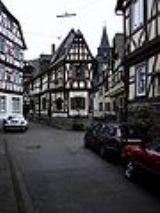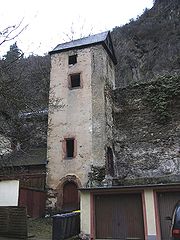
Braubach
Encyclopedia


Rhein-Lahn-Kreis
Rhein-Lahn is a district in the east of Rhineland-Palatinate, Germany. Neighboring districts are Westerwaldkreis, Limburg-Weilburg, Rheingau-Taunus, Mainz-Bingen, Rhein-Hunsrück, Mayen-Koblenz, and the district-free city Koblenz.-History:With the Congress of Vienna the area was added to the duchy...
, in Rhineland-Palatinate
Rhineland-Palatinate
Rhineland-Palatinate is one of the 16 states of the Federal Republic of Germany. It has an area of and about four million inhabitants. The capital is Mainz. English speakers also commonly refer to the state by its German name, Rheinland-Pfalz ....
, Germany
Germany
Germany , officially the Federal Republic of Germany , is a federal parliamentary republic in Europe. The country consists of 16 states while the capital and largest city is Berlin. Germany covers an area of 357,021 km2 and has a largely temperate seasonal climate...
. It is situated on the right bank of the Rhine, approx. 10 km southeast of Koblenz
Koblenz
Koblenz is a German city situated on both banks of the Rhine at its confluence with the Moselle, where the Deutsches Eck and its monument are situated.As Koblenz was one of the military posts established by Drusus about 8 BC, the...
. Braubach has assorted medieval architecture intact, including portions of the town wall, half-timbered buildings, and castle Marksburg
Marksburg
The Marksburg is a fortress above the town of Braubach in Rhineland-Palatinate, Germany. It is the only medieval castle of the Middle Rhine that has never been destroyed. It is one of the principal sites of the UNESCO World Heritage Rhine Gorge...
on the hill above.
Braubach is the seat of the Verbandsgemeinde
Verbandsgemeinde
A Verbandsgemeinde is an administrative unit in the German Bundesländer of Rhineland-Palatinate and Saxony-Anhalt.-Rhineland-Palatinate:...
("collective municipality") Braubach
Braubach (Verbandsgemeinde)
Braubach is a Verbandsgemeinde in the Rhein-Lahn-Kreis, in Rhineland-Palatinate, Germany. Its seat is in Braubach.The Verbandsgemeinde Braubach consists of the following Ortsgemeinden :...
.
History
In 1276 King Rudolf of Habsburg made Braubach a free city under Count Gottfried of Eppstein. Count Eberhard I. of Katzenelnbogen bought city and castle in 1283. Until 1479, the Counts rebuild the castle constantly. The castle was never conquered and never destroyed. The City of Braubach was the administration center of the katzenelnbogen wine production with Rhens, Spay, Boppard, Horchheim and Salzig and an amount of 33000 l of wine in 1438 and 84000 l of wine in 1443.In the 1845 travel guide Le Rhin
Le Rhin
Le Rhin is a travel guide written by Victor Hugo. Similar to Mark Twain's writings about the Mississippi, it includes many stories about the Rhine river. It ends with a political manifesto....
, Victor Hugo
Victor Hugo
Victor-Marie Hugo was a Frenchpoet, playwright, novelist, essayist, visual artist, statesman, human rights activist and exponent of the Romantic movement in France....
notes: "Then comes Braubach, named in a charter of 933, fief of the Counts Arnstein of Lahngau
Lahngau
The Lahngau was a medieval territory comprising the middle and lower Lahn River valley in the current German states of Hesse and Rhineland-Palatinate. The traditional names of the Gau are Loganahe Pagus or Pagus Logenensis....
; an Imperial city under Rodolph in 1270, a domain of the Counts of Katznellenbogen in 1283; accruing to Hesse in 1473; to Darmstadt, in 1632, and in 1802 to Nassau. Braubach, communicating with the baths of the Taunus, is charmingly situated at the foot of a high rock, crested by Marksburg, the castle of which is now a state prison. No marquis but must have his page: and the Duke of Nassau has the impertinence to pretend to prisoners of state! A royal luxury! Twelve thousand six hundred habitants, in eleven hundred houses; a bridge of thirty-six boats, built in 1819, across the Rhine; a stone bridge of fourteen arches upon the Moselle, upon the very foundations raised about 1311, by the Archbishop Baldwin, by means of an ample sale of indulgences; the celebrated fort of Ehrenbreitstein, surrendered to the French the 27th January, 1799, after a blockade during which the besieged paid three francs for a cat, and thirty sous per pound for horseflesh; a well one hundred and eighty feet deep, dug by the Margrave John of Baden; the square of the arsenal, where formerly stood the famous culverine the Griffin, which carried one hundred and sixty pounds, and weighed twenty thousand; an old Franciscan convent, converted into an hospital in 1804; a Roman N&tre Dame, restored in the Pompadour style, and painted pink; the church of St. Florin, converted into a magazine for forage by the French, and now a Protestant church, which is likewise painted pink; St. Castor, a collegiate church, embellished with a portal in 1805; and with all this no public library; such is the town which the French writers call Coblentz, out of politeness to the Germans, and the Germans Coblence, out of courtesy to the French."

